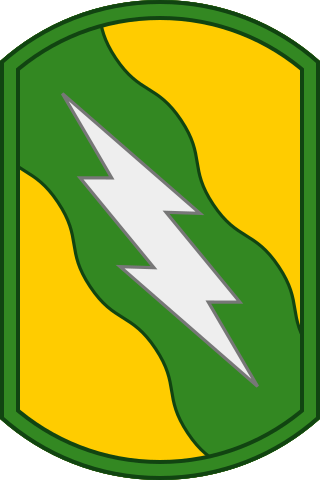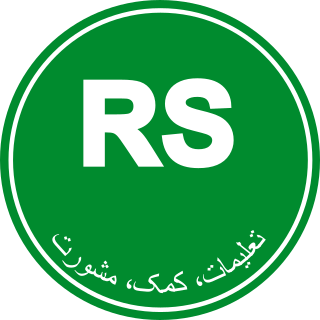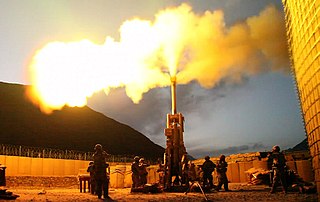
The 1st Infantry Division (1ID) is a combined arms division of the United States Army, and is the oldest continuously serving division in the Regular Army. It has seen continuous service since its organization in 1917 during World War I. It was officially nicknamed "The Big Red One" after its shoulder patch and is also nicknamed "The Fighting First". The division has also received troop monikers of "The Big Dead One" and "The Bloody First" as puns on the respective officially sanctioned nicknames. It is currently based at Fort Riley, Kansas.

The 4th Infantry Division is a division of the United States Army based at Fort Carson, Colorado. It is composed of a division headquarters battalion, three brigade combat teams, a combat aviation brigade, a division sustainment brigade, and a division artillery.

The 1st Cavalry Division is a combined arms division and is one of the most decorated combat divisions of the United States Army. It is based at Fort Cavazos, Texas. It was formed in 1921 and served during World War II, the Korean War, the Vietnam War, the Persian Gulf War, with the Stabilization Force in Bosnia and Herzegovina, the Iraq War, the War in Afghanistan as well as Operation Freedom's Sentinel and Operation Inherent Resolve. As of July 2023, the 1st Cavalry Division is subordinate to the III Armored Corps and is commanded by Major General Thomas M. Feltey.

The 9th Cavalry Regiment is a parent cavalry regiment of the United States Army. Historically, it was one of the Army's four segregated African-American regiments and was part of what was known as the Buffalo Soldiers. The regiment saw combat during the Indian and Spanish–American Wars. During Westward Expansion, the regiment provided escort for the early western settlers and maintained peace on the American frontier.

Below is an estimated list of the major units deployed within the Multi-National Force – Iraq and other United States military units that were operating in Iraq under the U.S. Central Command (USCENTCOM) in 2009, during the Iraq War.

The 8th Cavalry Regiment is a regiment of the United States Army formed in 1866 during the American Indian Wars. The 8th Cavalry continued to serve under a number of designations, fighting in every other major U.S. conflict since, except World War I, when it was not deployed to Europe because it was already engaged in the Punitive Expedition in Mexico from 1916 to 1920. It is currently a component of the 1st Cavalry Division.

Camp Taji, also known as Camp Cooke, is a military installation used by Iraqi and Coalition forces near Taji, Baghdad Governorate, Iraq. The camp is located in a rural region approximately 27 km (17 mi) north of the capital Baghdad.

The 3rd Brigade Combat Team, 1st Cavalry Division is a combined arms armored brigade of the 1st Cavalry Division based in Fort Cavazos, TX. Major equipment includes the M1A2SEP Tanks, M2A3 & M3A3 Bradley infantry fighting vehicles, M109A7 Paladin howitzers, and M1114 up-armored Humvees.

The 1st Battalion, 68th Armor Regiment is a battalion of the 68th Armor Regiment, United States Army.

Forward Operating Base Kalsu, also known as 'FOB Kalsu', COS Kalsu or simply Camp Kalsu, was a U.S. Military installation in Northern Babil Province, Iraq, 20 miles south of Baghdad. It was officially closed by members of the 1st Brigade Combat Team, 1st Cavalry Division, on December 12, 2011 as part of the US Army's withdrawal from Iraq.

The 53rd Infantry Brigade Combat Team is an infantry brigade combat team of the Florida Army National Guard. The 53rd Infantry Brigade is the largest National Guard unit in the state of Florida. The brigade was one of fifteen enhanced readiness brigades, designed and trained to support active duty divisions. The brigade includes 32 units in Florida and Alabama with 4,166 authorized personnel.

The 32nd Cavalry Regiment is a cavalry formation of the United States Army. From 1941 to 2000, it was an armor formation.

The 116th Cavalry Brigade Combat Team is the largest formation of the Idaho Army National Guard. It is headquartered at Gowen Field, Boise, Idaho. It has been reorganized into an Armored Brigade Combat Team (ABCT) but remains the only unit to be designated a "Cavalry Brigade Combat Team" by special appointment of the US Army. The 116th Cavalry Brigade Combat Team has units located throughout Idaho, Montana, Oregon, and Nevada. It was reorganized into a heavy armor brigade in 1989. Often referred to as the Snake River Brigade and formerly known as the 116th Armored Cavalry Regiment, the unit includes about 3,000 citizen-soldiers from Idaho.

The 155th Armored Brigade Combat Team is a brigade combat team of the Mississippi Army National Guard.

The 3rd Aviation Regiment is a regiment of the United States Army Aviation Branch. It operates the Boeing AH-64 Apache attack helicopter, Sikorsky UH-60 Black Hawk helicopter, and Boeing CH-47 Chinook helicopter. It has been associated with the 3rd Infantry Division for some time.
Qayyarah Airfield West is an Iraqi Air Force base in the Qayyarah subdistrict of Mosul District in northern Iraq. It was captured by U.S. Army during Operation Iraqi Freedom in 2003. It was also known as Q–West or Key West by the various U.S. Army Forces and civilian contractors stationed there. Control of the base was returned to Iraq in March 2020.

Forward Operating Base Shank is a former Forward operating base of the U.S. military, located in Logar Province of eastern Afghanistan, about 12 km south-east of the city of Baraki Barak. During Operation Enduring freedom, FOB Shank was one of the most heavily rocketed forward operating bases in Afghanistan. In 2014, the base was turned over to Afghan National Army, who established Camp Maiwand at the northern end of the FOB. American forces later returned and reoccupied the southern portion of the FOB, under the name Camp Dahlke.

First Squadron, 153rd Cavalry Regiment "Darkhorse" is an element of the Florida Army National Guard, headquartered in Panama City, Florida with units throughout the Panhandle. It was formerly 3rd Battalion, 124th Infantry and officially converted to cavalry on 1 September 2007 when the 53rd Infantry Brigade converted from a "separate brigade" to the brigade combat team structure.

Forward Operating Base Bostick, previously called FOB Naray, was a U.S. military outpost in the Kunar Province of Afghanistan. In July 2008, the name of the base was changed in memory of Major Thomas G. Bostick Jr. of Llano, Texas, who was killed in action.

The 221st Cavalry Regiment, Nevada Army National Guard, is a parent regiment under the U.S. Army Regimental System, with headquarters in Las Vegas, Nevada. It currently consists of 1st Squadron, 221st Cavalry Regiment a 600-soldier Armored Reconnaissance Squadron of the Nevada Army National Guard located in southern Nevada. For command and control purposes within the Nevada Army National Guard, 1st Squadron, 221st Cavalry Regiment, is a subordinate unit to the Land Component Commander (LCC) of the Nevada Army National Guard. In 2016, the squadron entered into an alignment-for-training relationship with the 116th Cavalry Brigade Combat Team, 34th Infantry Division. In May 2016, the squadron donned the Shoulder Sleeve Insignia of the 116th Cavalry Brigade Combat Team. As an armored reconnaissance squadron, the 1st Squadron, 221st Cavalry Regiment, is able to deploy three mechanized cavalry troops, one armor company, a support company, a headquarters troop, and a squadron headquarters in order to accomplish its federal, state, and community missions.





















